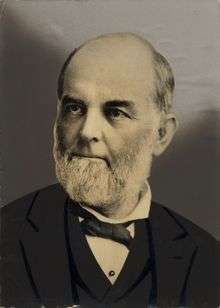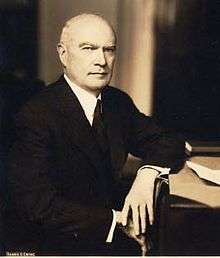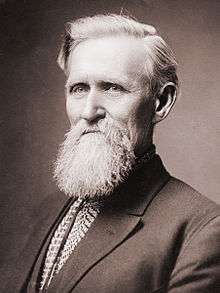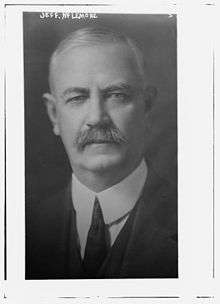Texas's at-large congressional seat
Texas has had at-large congressional seats at various times in its history. It was often the case when the state received new congressional seats as a result of reapportionment that instead of immediately redistricting the state's congressional districts, a new at-large seat would be elected by all the voters of the state.
History of at-large seats
From its admission to the Union in 1845, Texas has had single-member congressional districts; the first congressional delegation consisted of two House members in single member districts. This remained the case until after the Civil War and Reconstruction when Texas was awarded 4 seats in 1869 and two more in the 1870 census. As a result of the expansion from 4 to 6 seats, the two new seats were designated as At-Large and were elected statewide, so that each citizen elected three Members of Congress (one from their district and two statewide). By the elections of 1874, the legislature did redistrict the state into six single member districts, although they were not of equal population.
The Texas Constitution of 1876 required that the Legislature pass a redistricting plan during the first session after the publication of the decennial national census of the population. However, the Legislature sometimes did not follow through on this obligation.[1]
After the 1880 decennial census, Texas had the largest percentage gain in its congressional apportionment, from 6 members to 11. The legislature, in conformity with the state constitution adopted 11 single-member districts for the 1882 elections. Texas received additional congressional seats as a result of the 1890 Census and 1900 Census but quickly adopted single- member districts. After the 1910 Census, as a result of which, Texas received two additional seats and rather than redraw the districts, they were added as at-large seats. They remained at-large seats until the 1918 elections. The legislature decided to redraw the state's 18 districts almost at the end of the decade in an effort to punish Rep. A. Jeff McLemore of Houston for his opposition to President Woodrow Wilson (a fellow-Democrat) based on Wilson's decision to seek U.S entry into World War I. McLemore and fellow Houstonians Daniel E. Garrett (also an At-Large congressman) and Joe H. Eagle were all drawn into the 8th congressional district.[2]
As Texas received no additional seats until 1931, there was no need to redistrict. In 1931, with three more seats allotted to Texas, the legislature waited until 1933 to redraw the districting plan. "This resulted in the under-representation of the people in those districts where population grew faster than the rest of the state. The failure to redistrict favored the rural areas at the expense of Texas's growing urban centers. The latter's faster population growth meant they deserved additional seats in the state Legislature and the U.S. Congress."[3]
Voters amend the Constitution
The great imbalance in representation between declining rural populations and growing urban interests that had developed over the decades finally resulted in the voters adopting a state constitutional amendment in 1948 that gave the Legislature a deadline to enact a plan as specified under the original Constitution. The amendment provided that, if in the first legislative session after the publication of the decennial census of the population a redistricting plan was not adopted, the responsibility passed to a newly formed board, the Legislative Redistricting Board (LRB). The LRB is composed of the Lieutenant Governor, Speaker of the House, Attorney General, Comptroller of Public Accounts, and Commissioner of the General Land Office. "The prospect of the LRB determining district boundaries represented a significant incentive to the Legislature to seriously engage its redistricting obligation, as a LRB-authored plan would diminish significantly lawmakers' control over their own reelection fates."[3]
The next time that Texas received additional seats in Congress was as a result of the 1950 Census, in which Texas' population growth gave the state one additional seat. That seat remained at-large throughout the decade and the next redistricting plan was adopted in time for the 1958 general election. In 1960, Texas received one more member and again, the state's districts were not redrawn.
Equal population—the courts act
The Apportionment Clause of Section 2, Article I, of the United States Constitution, together with the amendment to that section made by Section 2 of the Fourteenth Amendment, requires seats in the U.S. House of Representatives to be apportioned among the states according to the “whole number of persons in each State” and to be elected “by the People of the several States.” These provisions have been construed to require not only that congressional seats be divided among the states according to population, but also that congressional districts within a state be drawn according to population.[4]
In the 1964 case of Reynolds v. Sims, the United States Supreme Court determined that the general basis of apportionment should be "one person, one vote." Reynolds v. Sims, 377 U.S. 533 (1964). This rule means that, generally, electoral districts must be equal in population according to the most recent census so that each person’s vote is equally weighted. This holding was applied explicitly to congressional districts by the Supreme Court in the 1964 case of Wesberry v. Sanders.
In Bush v. Martin, plaintiffs from two congressional districts asserted that the congressional districts in Texas were unconstitutional. The Federal District Court in Houston held Texas' Congressional Districting act to be unconstitutional and stated that the Texas Legislature must redraw the Texas Congressional Districts in compliance with Wesberry v. Sanders. Bush v. Martin, 224 F. Supp. 499 (S.D. Tex. 1963), affirmed, 376 U.S. 222 (1964).
The three-judge Federal District Court found that the population disparity among Texas Congressional Districts—ranging from 216,371 to 951,527—was "indeed spectacular" and noted that marked under-representation was "not surprisingly" found in metropolitan districts. Although Texas boasted a total of 254 counties, more than half of the population of the state was living in only eighteen counties and there were fifteen areas in the state that qualified for the label of "metropolitan."
During the 1965 legislative session, the state legislature passed a plan on May 31, 1965, realigning the state's 23 congressional districts into single-member districts.[5] Governor John Connally signed the bill allowing the new districts to take effect for the 1966 elections.
List of representatives
1873 – 1875
From 1873 to 1875, Texas elected two members at-large, as well as electing others from districts.
| First seat | Second seat | ||||||
|---|---|---|---|---|---|---|---|
| Years | Representative | Party | Electoral history | Representative | Party | Electoral history | |
| March 4, 1873 – March 3, 1875 |
 Roger Q. Mills Roger Q. Mills |
Democratic | Redistricted to the 4th district |  Asa H. Willie Asa H. Willie |
Democratic | Retired | |
1913 – 1919
Texas re-established an at-large seat in 1913 electing two members at-large following the 1910 United States Census, as well as electing others from districts until 1919.
| First seat | Second seat | ||||||
|---|---|---|---|---|---|---|---|
| Term | Representative | Party | Electoral history | Representative | Party | Electoral history | |
| March 4, 1913 – March 3, 1915 |
Daniel E. Garrett | Democratic | Lost renomination |  Hatton W. Sumners Hatton W. Sumners |
Democratic | Redistricted to the 5th district | |
| March 4, 1915 – March 3, 1917 |
 James H. Davis James H. Davis |
Democratic | Lost renomination |  A. Jeff McLemore A. Jeff McLemore |
Democratic | Lost re-election when redistricted to the 8th district | |
| March 4, 1917 – March 3, 1919 |
Daniel E. Garrett | Democratic | Retired when redistricted to the 8th district | ||||
1933 – 1935
Texas re-established an at-large seat in 1933 electing three members at-large following the 1930 United States Census, as well as electing others from districts until 1935.
| First seat | Second seat | Third seat | |||||||||
|---|---|---|---|---|---|---|---|---|---|---|---|
| Years | Representative | Party | Electoral history | Representative | Party | Electoral history | Representative | Party | Electoral history | ||
| March 4, 1933 – January 3, 1935 |
Joseph Weldon Bailey, Jr. | Democratic | Retired to run for U.S. Senate | Sterling P. Strong | Democratic | Lost re-nomination | George B. Terrell | Democratic | Retired | ||
1953 – 1959
Texas re-established an at-large seat in 1953 electing one member at-large following the 1950 United States Census, as well as electing others from districts until 1959.
| Years | Representative | Party | Electoral history |
|---|---|---|---|
| January 3, 1953 – January 3, 1959 |
 Martin Dies, Jr. Martin Dies, Jr. |
Democratic | Retired |
1963 – 1967
Texas re-established an at-large seat in 1963 electing one member at-large following the 1960 United States Census, as well as electing others from districts until 1967.
| Years | Representative | Party | Electoral history |
|---|---|---|---|
| January 3, 1963 – January 3, 1967 |
 Joe R. Pool Joe R. Pool |
Democratic | Redistricted to the 3rd district |
References
- ↑ Brown, et al. Practicing Texas Politics, 11th Edition (2001), p. 222
- ↑ Keith, Jeanette. Rich Man's War, Poor Man's Fight:Race, Class and Power in the Rural South during World War I. Chapel Hill, NC: University of North Carolina Press, 2004. p. 169.
- 1 2 Texas Politics, Liberal Arts Instructional Technology Services, University of Texas at Austin, 2006
- ↑ Texas Legislature's Guide to Redistricting
- ↑ Washington Post May 31, 1965 p.A3
Further reading
- Martis, Kenneth C. (1989). The Historical Atlas of Political Parties in the United States Congress. New York: Macmillan Publishing Company.
- Martis, Kenneth C. (1982). The Historical Atlas of United States Congressional Districts. New York: Macmillan Publishing Company.
- Congressional Biographical Directory of the United States 1774–present